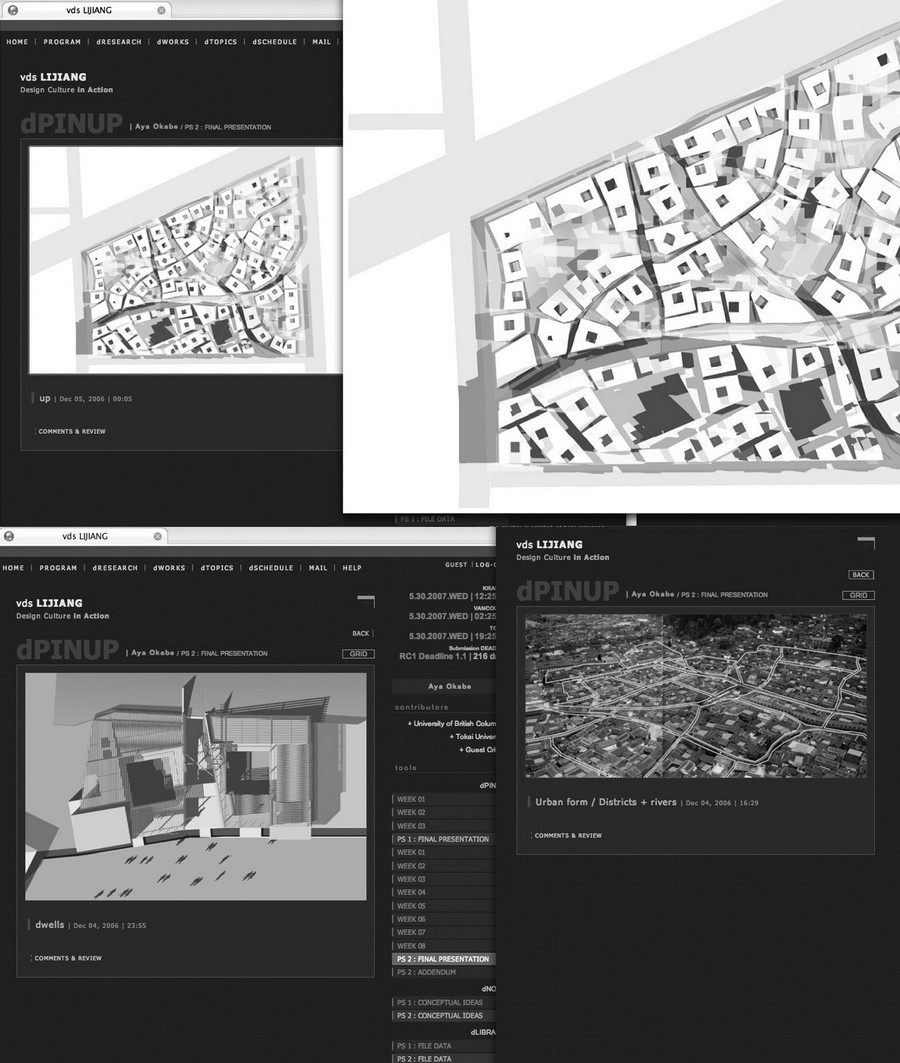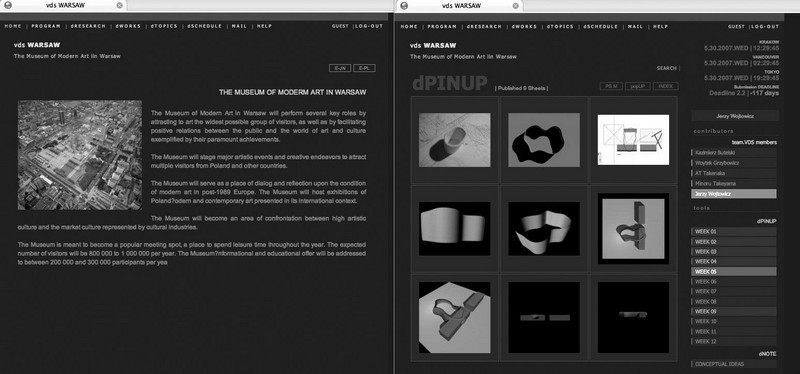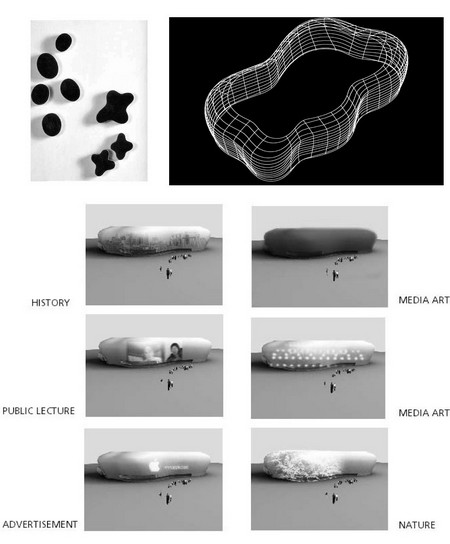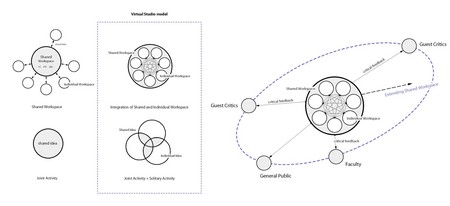2(3) 2008
 |
|
 |
ARCHITECTURE AND MODERN INFORMATION TECHNOLOGIES
ÌÅÆÄÓÍÀÐÎÄÍÛÉ ÝËÅÊÒÐÎÍÍÛÉ ÍÀÓ×ÍÎ-ÎÁÐÀÇÎÂÀÒÅËÜÍÛÉ ÆÓÐÍÀË ÏÎ ÍÀÓ×ÍÎ-ÒÅÕÍÈ×ÅÑÊÈÌ È Ó×ÅÁÍÎ-ÌÅÒÎÄÈ×ÅÑÊÈÌ ÀÑÏÅÊÒÀÌ ÑÎÂÐÅÌÅÍÍÎÃÎ ÀÐÕÈÒÅÊÒÓÐÍÎÃÎ ÎÁÐÀÇÎÂÀÍÈß È ÏÐÎÅÊÒÈÐÎÂÀÍÈß Ñ ÈÑÏÎËÜÇÎÂÀÍÈÅÌ ÂÈÄÅÎ È ÊÎÌÏÜÞÒÅÐÍÛÕ ÒÅÕÍÎËÎÃÈÉ
VIRTUAL STUDIO - DISTRIBUTED TEACHING AND LEARNING OF DESIGN IN A NETWORKED ENVIRONMENT
ÂÈÐÒÓÀËÜÍÀß ÑÒÓÄÈß - ÐÀÑÏÐÅÄÅËÅÍÍÎÅ ÎÁÓ×ÅÍÈÅ È ÈÇÓ×ÅÍÈÅ ÏÐÎÅÊÒÈÐÎÂÀÍÈß Â ÑÅÒÅÂÎÌ ÏÐÎÑÒÐÀÍÑÒÂÅ
Jerzy Wojtowicz, Tsukasa Takenaka
The University of British Columbia, Canada
[email protected], [email protected]
Introduction
Today, majority of designers work in the highly structured, digital environment. With the growing frequency projects are developed in joint ventures with the geographically dispersed team members. Projects are often intended for the remote sites, or clients. While the contemporary design could be seen as the report from the current state of the database [Mitchell], theaccessibility to this collectively developed database of design knowledge remains limited and far from ideal.
The contemporary designer is typically facing only single image on a single computer screen, without easy access to its history. The old fashion, analogue pinup board provided much more. Since the introduction of digital environment the social character of the traditional studio is under duress. In many schools student-designer works alone relating to the project through the “pass-part-out” of the laptop-screen, while located away from the school, other classmates and critics. The casual peer feedback and social space, so characteristic to the traditional studio, is increasingly limited and can not be replaced by the occasional, formal review.
Could the positive aspects of traditional studio be salvaged and implemented in the context of the virtual one? The communication capability of the digital media affords access to the distant condition with ease. We can link with partner across the several time zones, seek the advise of consultant whom we never met, or contribute to the joint client/user presentation using newmedia and techniques. Yet, as the result of the ongoing popularization of information technology the traditional studio format is in crisis while the new mode practice has yet to be formed.
Over the decade virtual design studios experiments at UBC involved distributed collaboration among several international academic institutions. More recently architecture students and participating designers were provided with an new educational experience utilizing revised VDS environment. Information Technology become accepted as MEDIA - not just as a drafting or modeling tool. This phenomenon is perhaps due to the rapid dissemination of computing literacy and to the progressive accessibility and ease of use of digital technology. The impact of ITrevolution on design practice and education is now massive, since broadband networks are more widespread. Networked communication is transforming our lives through the new methods of direct access to distanced individuals and issues. With the proliferation of the internet it is now possible to share working environment. The following case studies illustrate recentapplication of virtual studio method and its potential social impact.
Case 1: vds dMEDIA
The initial case illustrates foundation design media course for the first year architecture students. Basic design education was initially formed at Bauhaus out of the conviction that designs for mass production and modern architecture needed a new fundamental strategy. “Exact knowledge of material and machine are equally necessary to give the product organic function”(1). Today, seventy-five years later, the modern, basic design pedagogy needs to be revisited as we begin to deal with the new machinery.
The dMEDIA course is intended to make students engage the digital techniques in parallel with the design agenda. What are the critical opportunities of new media in design? There are few, first, the creative aspects of digital media in the design process; second, the role of projections and motion in generating and representing the design, finally there is an issue of distributed design collaboration across networks. Among the current trends in design is the growing application of complex surfaces resulting from the proliferation of NURBS modelers. Furthermore, motion models, animation and kinematics are engaged not only in designrepresentation, but also in its generation and in questioning the established nature of the design discipline. Quick prototyping with numerically controlled tools offer the promise of new relation of design to the act of its production, perhaps ultimately challenging the traditional role oforthogonal aspect and abstraction in design.
The course deals with the above new media opportunities through deployment of short, machine-based design exercises. These problems, set as digital design etudes are tightly framed, addressing limited aspects of design with the new media, while formulating thepedagogy and fundamentals of digital design.The dMEDIA course is deliver largely over the internet to the group of forty students and it aspires to retain character and atmosphere of the traditional design studio. The design of our portal including digital pinup space - DPINUP with related comments and threaded discussions, dRESEARCH and dSCHEDULE provedparticularly successful.
 |
|
Fig 1. Few web pages from vds dMEDIA, 2007 |
Case 2: vdsLIJIANG
Second case study illustrates structure of vertical design studio for M.Arch. program students. Design problem was situated in the province of Yunan of China and designers had to work in the initially unfamiliar context, that called for extensive collective design research. The condition of remote problem solving is increasingly common, as the process of denationalization ofmarkets and politics stimulates the growth of the global economy. The built urban heritage and the traditional culture that evolved gradually over time is often abruptly disrupted by forces of cultural colonialism and consumerism. The fragile vernacular architecture, the product of a sustainable environmental, cultural, and material system, offers many lessons to contemporary design culture beyond the picturesque. Working in the remote area broaden experience and helps students to fulfilling their obligations as global citizens.
Distributed and intercollegiate projects among educational institutions has been tried for some time (2). In the Virtual Design Studio, the design process is addressed across geographic and cultural boundaries. As design becomes a form of correspondence and as architecture begins to be practiced anywhere and at any time, we are seeing designers operating outside the limits of its locality. In architecture, the universal expansion of the Internet and resulting connectivity becomes a significant factor in the redefinition of design media and conventions. IT expands the possibilities of creative work when computers are regarded not only as tools, but also as the medium and the means to involve others in the design process. Previously marginalized citizens now have potentially direct access to the design process. If taken advantage of, this opportunity might dramatically change and expand the nature of architectural practice. In the introduction to studio we wrote: Contemporary design teams are structured more like film production groups, or multidisciplinary social units. They come together for short-term, intense tasks and assume a different guise after the completion of each project. With the rapid world wide cultural changes and technological advancements, the information society is no longer a dream – it is the reality! As we design for the XXI century we should ask: What kind of architecture will respond to the dynamic quality of our emerging civilization, and what is the nature of design culture in action, particularly when situated against the rich and often neglected vernacular built heritage? No doubt the social conventions and political agendas are reformulated in order to follow thedramatic changes in information technology.
 |
|
Fig. 2 |
 |
|
Fig. 3 |
|
Fig. 2 and Fig. 3. Few screens from vdsLIJIANG, 2006 |
Today the nature of design education has to be re-invented and re-built for digital media. We need to prepare students for the current practices of architecture, research and design in a global knowledge society. Our aims are to expose and integrate distributed design education, with parametric modeling, robotics and digital fabrication. We have to reach out to prospective students and to address problems of previously remote and marginalized societies by fostering situated case studies, design simulations and design-build community projects at distantlocations. Our overriding objective remains the same - to offer a competitive and second-to-none design education for a growing global student audience. The internet-based program addressing global design education market is now possible. Virtual Studio method helps to discover and disseminate new knowledge as well as prepare design students to operate in a distributed problem-solving environment while furthering their critical thinking abilities
 |
|
Fig.4. Few screens from vdsMOMA |
Case 3: vdsMOMAwa
Contemporary Virtual Studio environment offers new mode of practice for design professionals as illustrated in the last case study. Aim of this project was not only to foster virtual linksbetween often geographically or temporally dispersed competition participants, but also todevelop design research and creative design ideas otherwise impossible. The structuredprovision of a digitally augmented social studio space brought dispersed team members together.
Site for the competition for Museum of Modern Art in Warsaw (MoMAWA) located in the shadow of once totalitarian symbol, erected in the midst of destroyed city. While its immediate context was charged with the painful collective memories, the project design pointed to the future. It was conceived to become an interactive landmark for Warsaw citizens - celebrating publicparticipation, the new age of freedom and its Art. MoMAWA project was composed out of the two formal geometries. The seemingly biomorphic, free-flowing form of the exhibition area alludes to the rich tradition of the modern art and to the significance of nature in our young culture. The 1931 painting of Jean Arp gave conceptual synthesis to this notion. The second conceptual aspect of the project was derived from topology. Its skin changes and differentiate with a passage of time.
The composite toroidal shell of the exhibition areas engaged translucent box of the rental areas. The sweeping, flat-white exterior surfaces of the exhibition shell are finished with carbon-fibertex panels and designed to receive projected display and materiality from the surrounding networked, per formative media screen. This screen is tracing the boundary of the project unifying it into a coherent entity. This installation is instrumental in making the MoMAWA project into a dynamic, ever changing “object-event”. The programming of the displays on the outside of the building surface as well as the inside displays was to be controlled by museum curators. The modern audience capability to interact through personal digital devices, like IPhone , or cell phone was considered. Per formative display system consisting of variable grid of “media-pods” was interactive. It empowered the citizens of Warsaw to take active role in its real time programming, shaping and even determining the materiality of the museum surface. This system extended the notion of public art, poster and graffiti to the new condition of tomorrow. Conditions of grid consisted of dislocation, vacancies and interstitial placements of “media-pods” - all without affecting to the periphery. The interactive grid was adjustable to the activities of the museum and public.
Fig. 5 Fig. 6 Fig. 5 and Fig. 6. Diverse critical ideas by the dispersed participants of the international competition team in case of vdsMOMA


On Method
Remote problem solving, distributed design collaboration, and education delivery togeographically isolated participants are all now all possible within the virtual design studio. The distributed pilot design studio environment is being setup in order to deliver the followingaspects of the project. Dynamic web portal, with PHP, on a dedicated server was used for virtual studio projects and design courses.Virtual digital pinup “walls” for distributed juries and casual browsing as well as joint multidisciplinary and mobile projects are now considered. Synchronous and asynchronous environment for critical feedback in design process and the remote connectivity for advanced architecture students during their fieldwork is possible. Furthermore integration of streamed video delivery of public lectures series and school wide juries, faculty training in virtual studio environment and its integration to design teaching was proposed in our recent grant application.
Virtual Studio is the dynamic web portal with PHP (hypertext preprocessor), placed on a dedicated server for design competitions, studio and design courses. Virtual Studio portal can be seen also as form of social space for sharing each individual design spaces. Initially we used FTP and BBS for sharing data and design idea. But today the individual spaces based on our design process include timeline idea, image drawing, data collection, data sharing, critics, archives. Sharing “work process” enable us to promote interaction of our works, and intensify our collaborative and creative design labors. A main tool of the site is virtual digital pinup "walls" called “dPINUP” for distributed juries, joint multidisciplinary and mobile projects. This dWalls can give rise a new way of “image communication” in design. Another possibility is to use this portal as design portfolio for presenting your work to other VDS members, or to the general public. For this function, you can choose different level of security for your work. The other tools for individual space: dNOTE - concept notebook, tool for text based pinups, dLIBRARY or data files library used for uploading CAD files, PDF files etc, dLINK with bookmarking function and dSCHEDULE or tool for scheduling and management of design project.
 |
 |
|
Fig. 7 |
Fig. 8 |
|
Fig. 7 and Fig. 8. Models of Traditional and Virtual Studio | |
The Virtual Studio project is dedicated to promotion of design education and its content dynamically controlled and maintained by its participants. The content, integrated with digital media, will be enhanced in the near future. Architecture design studios will operate withenhanced connectivity, stream video and iChat. It will reach out to remote communities and a new student population. Web based professional and continuing education environment for local Architectural Institute programs is possible. A significant enrollment increase due to the virtual studio environment as well as growing number of partially remote foreign students is anticipated. After the testing and setup period, the overall student population will be impacted, involving more students and faculty. Further benefits are anticipated throughout increased enrollment in summer courses, global visibility and recruiting. In addition program will becapable to reach out audiences and areas of social concern that are otherwise marginalized. The VDS team is currently planning its future guise as illustrated in the concluding diagrams.
 |
|
Fig. 9 New prospects for the extended VDS environment |
(1) Moholy-Nagy, L., “New Approach to Fundamentals of Design”. 1938, Chicago, in Wingler, H., The Bauhaus, MIT Press, 1985.
(2) See Wojtowicz, J., Virtual Design Studio, 1994, HKU
References
Wojtowicz, J., Davidson, J., Mitchell, W.J., 1992 "Design as Digital Correspondence", Computer Supported Design in Architecture , Keenest, K., Noble, D. (ed), the Association for Computer Aided Design in Architecture, pp.98-102.
Wojtowicz, J., . (ed.): 1994, Virtual Design Studio, Hong Kong University Press
Wojtowicz, J., Butelski K., 1999,“Lessons from Distributed Design Practice in Architectural Computing”, From Turing to 2000, University of Liverpool, pp.482- 487.
Wojtowicz, J., 2004, “Space, Time and New Media - Virtual Design Studio Revisted”, in Bento, J. Duarte J., Mitchell W.J. (ed), Collaborative Design and Learning - Competence Building for Innovation, Praeger,, pp. 351 -375















